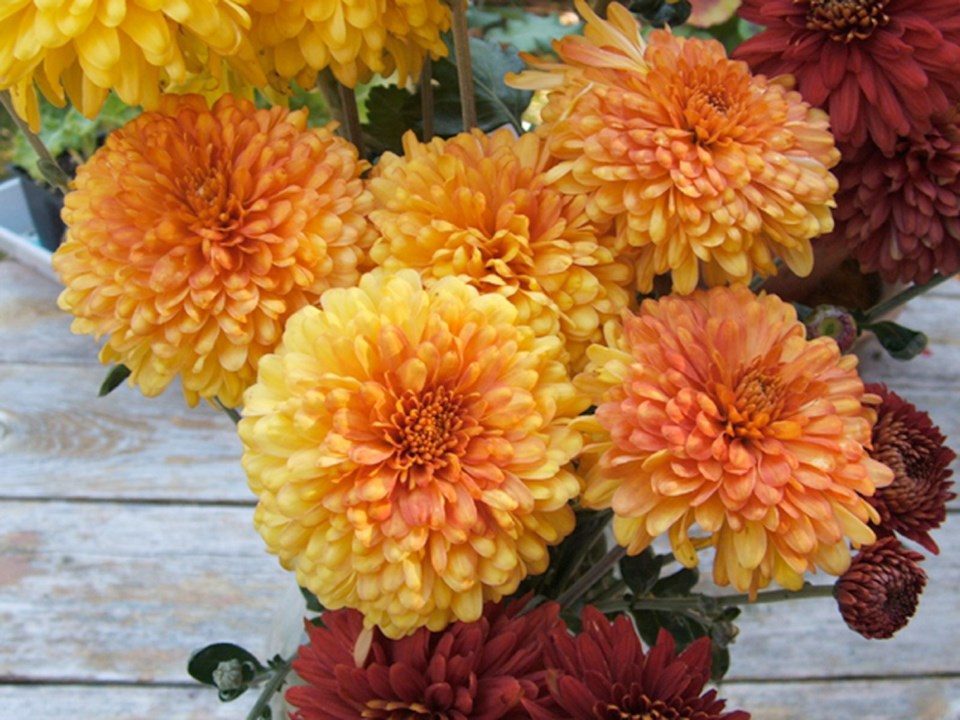Dear Helen: My mother is very fond of chrysanthemums. I’d like to give her a potted “mum” for Christmas, but I’m told they are very difficult house plants. Is this true?
G.C.
Potted chrysanthemums do require the often difficult combination of bright light, high humidity, and cool temperatures. Homes kept toasty warm throughout will usually result in plant wilting and a shortened bloom period. The plant will sometimes do all right when placed in a cool area at night. The soil needs to be kept consistently moist.
Potted azaleas and cyclamen need similar cool, bright conditions. One gift plant that does well in warm room temperatures is African violet, though it also needs fairly high levels of humidity.
If your mother’s favourite flower is chrysanthemum, and she enjoys a very warm home, consider a bouquet of cut mums. They are very showy, long-lasting cut flowers.
Dear Helen: From reading your column, I gather you are out in the garden year round, in all sorts of weather. I need to know where you find the motivation to work outdoors in gloomy, cold, wet conditions.
B.I.
To be clear, I try to avoid gardening on wet, rainy days. I dislike returning indoors soggy and smeared in mud. Besides, gardening in wet conditions is rarely productive and probably not very good for the garden either.
That said, the best motivation I know of for gearing up to garden on dark, chilly days is to have projects you’d very much like to have accomplished by spring. For example, I’m currently experiencing a strong compulsion to complete the cleaning and weed-suppression measures on more of the back garden paths that I began re-configuring last fall.
That project would help to set the back garden up nicely for the spring, as would finishing the last of the pruning on two old climbing roses and a honeysuckle vine. There remain numerous beds to tidy, lawn that needs re-edging and so on. Almost every garden could do with some winter work. The sites and situations that bother me the most are the ones I address most urgently.
In some gardens, numerous egregious messes can be overwhelming enough to induce a paralyzing inertia that can be overcome with a little appropriate help called in to tame overgrowth and clear difficult spots. Once the “heavy-lifting” part of a project is taken care of, the motivation will appear to make happily manageable follow-up refinements.
Some gardeners may perhaps harbour another motivation that I must admit to: Pride. I would delight in having the garden in decent enough shape to welcome more visitors to it. In the earlier days of this garden I occasionally led small groups through the garden, answering questions along the way. That’s another goal that motivates me as I garden in the cold.
Dear Helen: My husband and I are avid gardeners, but we struggle sometimes when it comes to choosing soil amendments from among the bewildering selection of products available. In particular, we’ve been trying to decide on the most sustainable material for retaining soil moisture. You have mentioned using coconut fibre (coir) rather than peat, but we have come across articles suggesting coir is not always squeaky clean in the resources used and conditions involved in its production.
K.H.
I agree that the dizzying array of bagged soil amendment products at garden supply outlets does present a sort of mine field for gardeners, especially for those concerned with ethical and environmental issues associated with their production.
The ideal would be to produce enough home-made compost for maintaining a spongy, moisture-retentive texture in our garden soils, but in many home garden conditions that’s not possible.
That leaves us to weigh the human and ecological costs of products against their benefits. In choosing between peat and coir for mixing into garden soils, I still opt for coir.
I once wrote a magazine article on peat. The project involved a visit to peat bogs and a processing facility — and extensive research. I learned that peat grows at the rate of one mm per year. Once harvested, it takes centuries to re-grow.
Coir is the fibrous outer coat on coconut shells — a material that is continually and rapidly renewable as coconut palms produce year round and yield around 50 coconuts annually.
Another consideration is that peat is very acidic, while the pH (acid-alkaline scale) of coir is closer to neutral and suited for the needs of most plants.



